Tuesday, June 25, 1929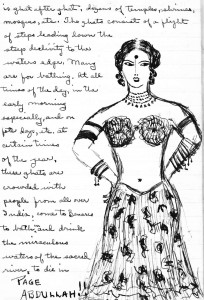
Changed trains at Moghal Sarai this morning after eight. From here it was but a few minutes run to the Ganges. As the train rolled slowly across the big steel bridge, we saw the river ghats and spires and minarets of Benares, the holy of holiest cities of the Hindus. Many people leaned out of the car windows and threw coins (pies) into the sacred Ganges. A number of boys ran back and forth pocketing those coins that hit girders and fell on the bridge. I would like to join that crowd. Benares is built on only one side of the river, the north, and on the south open fields stretch away. As Agra, the country encircling Benares is flat and sandy.
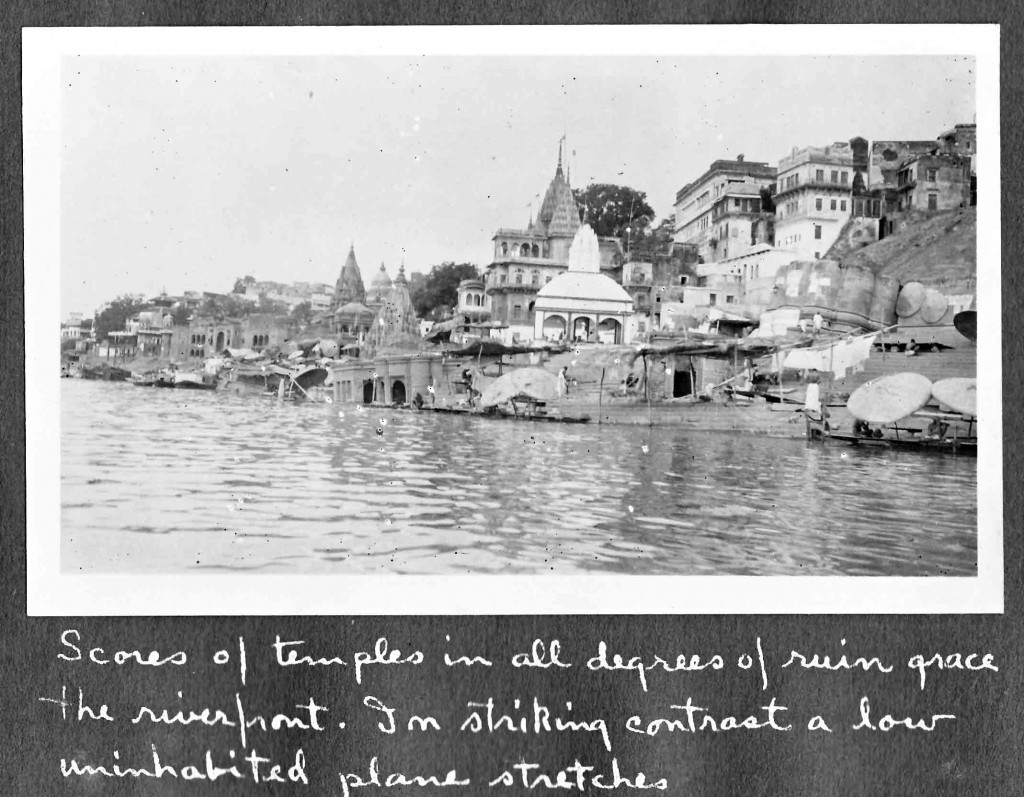
Frank and I left Mort with the baggage while we went in search of the Dak Bungalow. As we have found everything else in Benares, it was higher priced 1/8 a day and meals and miscellaneous. About this time it began to pour, and I was pretty wet by the time we were settled in the DB.
Having had but a cup of tea for breakfast, we ate our chhota hazri of eggs, toast, and tea for lunch. Tried to rent bikes but they were 1/8/0 a day and the man wouldn’t bargain. We found a bus service (such as it was) to the native city for two annas.
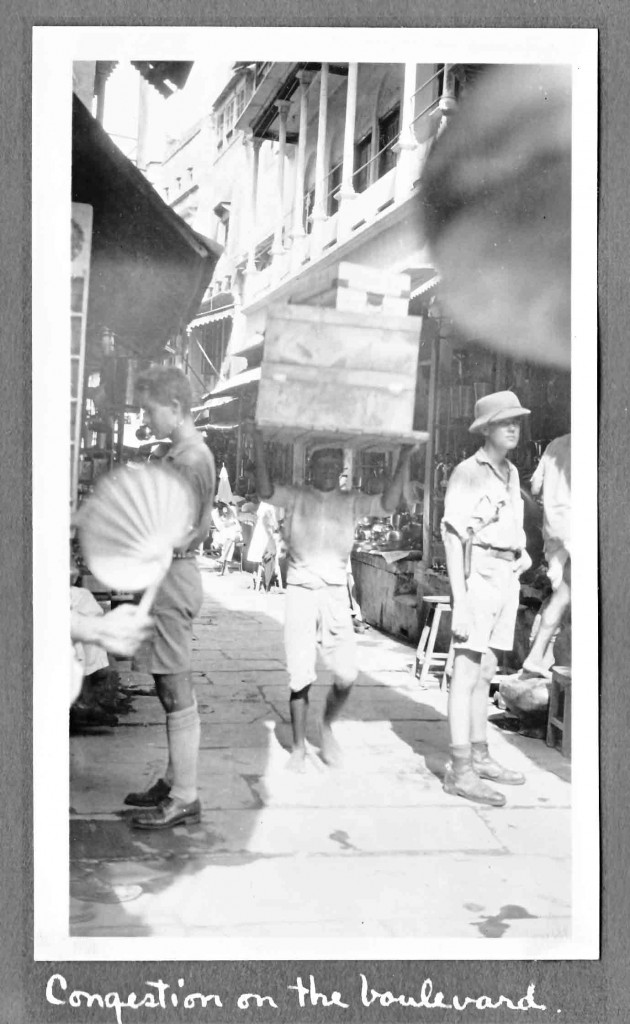 Soon we were lost in a labyrinth of squeezed-in, twisted alleyways—an utterly hopeless convolution of passages as far as keeping one’s bearings went. These were far better (or worse) than those of Venice. Scarcely four feet wide, they twisted this way and that, leading off into blind alleys, up steep flights of steps. The buildings were mostly of three or four storeys in height and shut out much light in some places. Often arches joined two opposite buildings together. These structures were all old, many having colored pictures of gods and soldiers painted on their white-washed fronts. The streets were for the most part paved with large flagstones and were pretty dirty. They were full of beggars and sacred cows. As is the usual run of bazaars, the brass works are all in one section, cloth merchants in another, et cetera.
Soon we were lost in a labyrinth of squeezed-in, twisted alleyways—an utterly hopeless convolution of passages as far as keeping one’s bearings went. These were far better (or worse) than those of Venice. Scarcely four feet wide, they twisted this way and that, leading off into blind alleys, up steep flights of steps. The buildings were mostly of three or four storeys in height and shut out much light in some places. Often arches joined two opposite buildings together. These structures were all old, many having colored pictures of gods and soldiers painted on their white-washed fronts. The streets were for the most part paved with large flagstones and were pretty dirty. They were full of beggars and sacred cows. As is the usual run of bazaars, the brass works are all in one section, cloth merchants in another, et cetera.
Being a sacred city, Benares is satiated with temples, shrines, mosques, and holy places of worship. Though the city is Hindu, the Moslems have some mosques here, the chief of which is the Auranzeb Mosque (Auranzeb, son of Shah Jahan and the one who deposed him from his throne), the minarets of which rise gracefully above the tangle of houses and shrines near the sacred river. The Jains have two or three bathing ghats on the riverbank.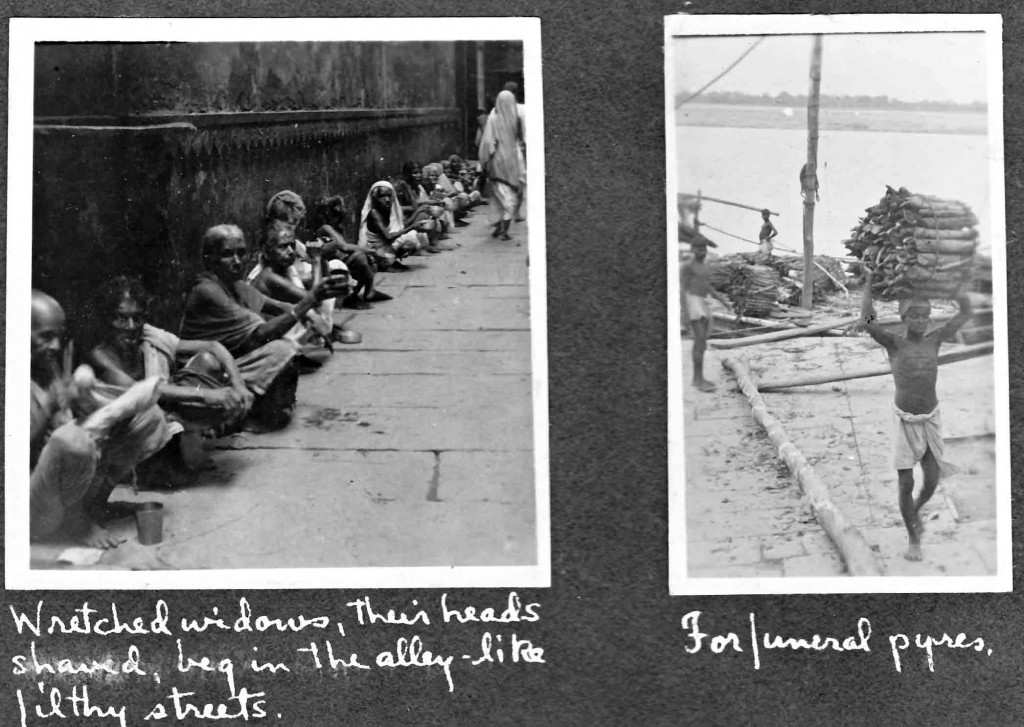
It is said that those who die on the bank of the Ganges or Holy Kashi as Benares is sometimes called—those fortunate enough to die here will not be reborn into this world but will, I suppose, remain in heaven. This causes many old folks to leave home and come here to die. Thus there are many, many beggars on the streets, old, decrepit, worn out pieces of humanity, come here to spend their last days and die by the Ganges. They are nauseating to look at—dirty, haggard, hideous, deformed, wrecks of mere skin and bones, covered by a few filthy rags, squatting or hobbling by the street-side, whining for alms with their decayed mouths. Old hags, skeletons of men, half dead from hunger and old age, lepers—a conglomeration of the wrecks and outcasts of humanity—a sickly sight to see.
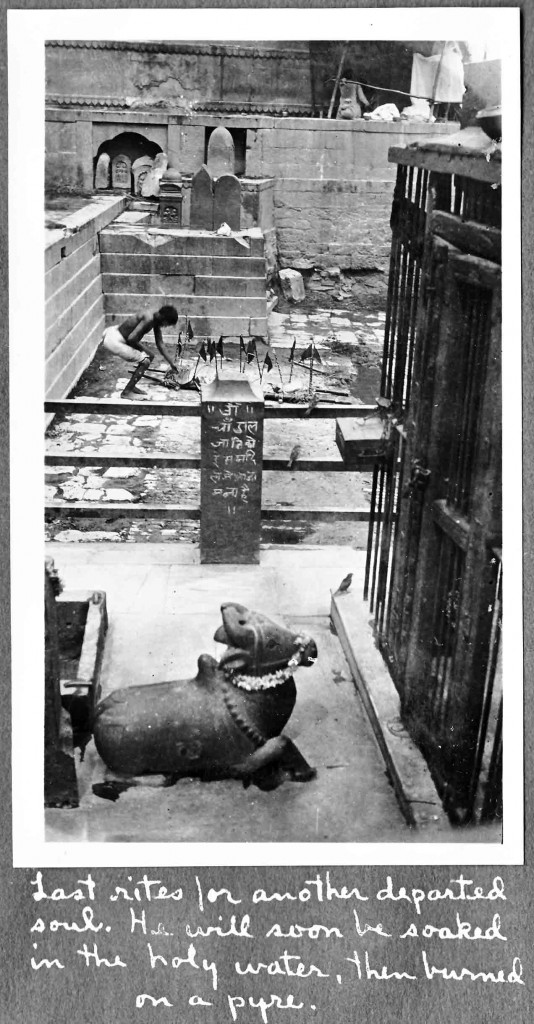 Shrines are everywhere—at corners, in blind alleys, in half-concealed courts—everywhere, their sculptured spires swallowed up in a maze of encompassing edifices. In them are idols of a great variety of Hindu gods and goddesses, and many phallic stones. These latter are to be seen by the scores as the lingam is much worshipped here by all. Peeping in at the open doorways you often are surprised to find a good-sized Hindu temple where you would never guess the existence of one. These too are full of idols, mostly Ganesh, and phallic stones.
Shrines are everywhere—at corners, in blind alleys, in half-concealed courts—everywhere, their sculptured spires swallowed up in a maze of encompassing edifices. In them are idols of a great variety of Hindu gods and goddesses, and many phallic stones. These latter are to be seen by the scores as the lingam is much worshipped here by all. Peeping in at the open doorways you often are surprised to find a good-sized Hindu temple where you would never guess the existence of one. These too are full of idols, mostly Ganesh, and phallic stones.
The Ganges at Benares is a good-sized river. Along its bank for perhaps three miles is ghat after ghat, dozens of temples, shrines, mosques, etc. The ghats consist of a flight of steps leading down the steep declivity to the water’s edge. Many are for bathing. At all times of the day, in the early morning especially, and on fete days, etc. at certain times of the year, these ghats are crowded with people from all over India, come to Benares to bathe in and drink the miraculous waters of the sacred river, to die in Holy Kashi. It is a proven fact scientifically that these waters really do possess powers of healing—a chemical composition that destroys cholera germs in six hours and probably others. It is said that those who die here, no matter of what creed, will go straight to heaven for Benares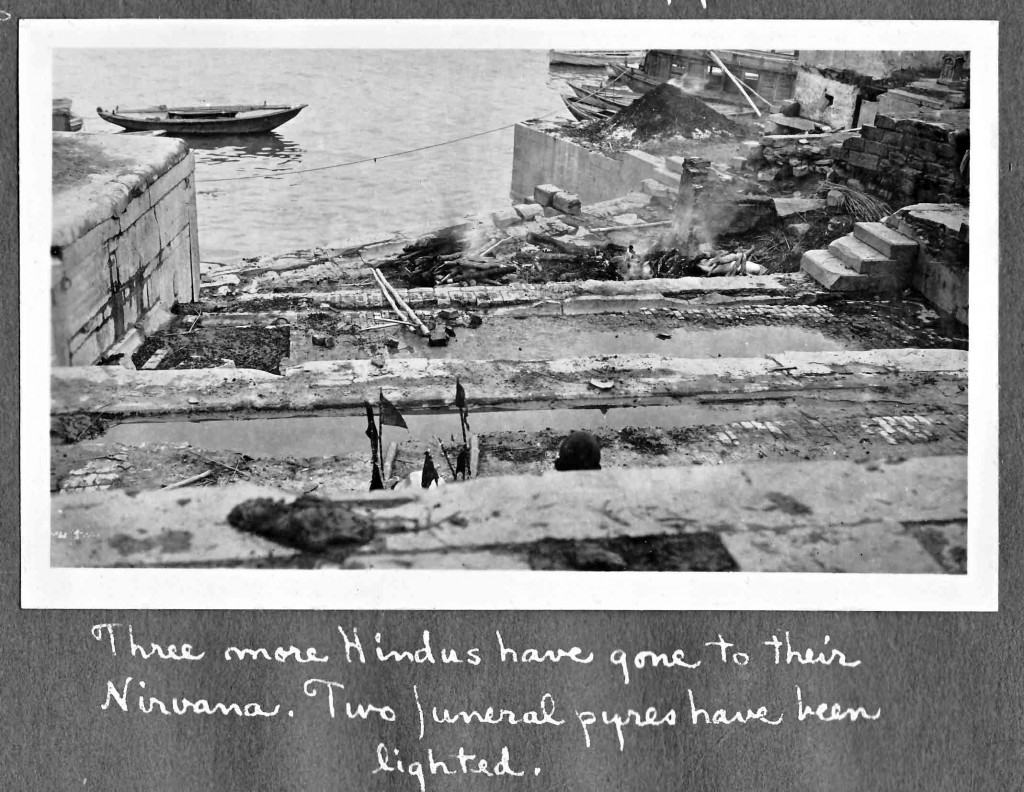 combines the best of all places. Our aimless wandering brought us at last to the river at some distance below the mosque at one of the large ghats. There were but few people there at this hour—afternoon—except those who were sitting in the many shrines and temples that were everywhere. We wandered along the bank from ghat to ghat. At one point we came upon an old man lying in the path to the left, a mere skeleton. We stopped to gaze at him for he appeared to be dead. Sure enough—a passing coolie said “dead,” nodding to the old man. He had probably come to Benares to die, had crawled down by the river and just died there. He had probably been lying there a few days and the chances are that he will be there a few days more, till some passing rich pilgrim buys some wood and has his body burned. This life means little to the Hindu who looks forward to the next life with anticipation. The body is but the house for the soul in this world, and after death it means nothing and no sentiment is attached to it.
combines the best of all places. Our aimless wandering brought us at last to the river at some distance below the mosque at one of the large ghats. There were but few people there at this hour—afternoon—except those who were sitting in the many shrines and temples that were everywhere. We wandered along the bank from ghat to ghat. At one point we came upon an old man lying in the path to the left, a mere skeleton. We stopped to gaze at him for he appeared to be dead. Sure enough—a passing coolie said “dead,” nodding to the old man. He had probably come to Benares to die, had crawled down by the river and just died there. He had probably been lying there a few days and the chances are that he will be there a few days more, till some passing rich pilgrim buys some wood and has his body burned. This life means little to the Hindu who looks forward to the next life with anticipation. The body is but the house for the soul in this world, and after death it means nothing and no sentiment is attached to it.
 A short distance on we came to a burning ghat. Here the bodies are cremated on funeral pyres of logs. As we arrived they were setting fire to two of these pyres; a third corpse was lying nearby wrapped in a loud red cloth, and reposing on an ornamented bamboo stretcher bedecked with red and yellow flags. A fourth body lay in an unlighted pyre, and still a fifth lay wrapped in white cloth down near the water’s edge, still wet from his recent ducking.
A short distance on we came to a burning ghat. Here the bodies are cremated on funeral pyres of logs. As we arrived they were setting fire to two of these pyres; a third corpse was lying nearby wrapped in a loud red cloth, and reposing on an ornamented bamboo stretcher bedecked with red and yellow flags. A fourth body lay in an unlighted pyre, and still a fifth lay wrapped in white cloth down near the water’s edge, still wet from his recent ducking.
The custom is to dip the body in the Ganges, then plaster up the ears, mouth and nose with mud so that the departed spirit cannot reenter the “old house.” The corpse is later put on a funeral pure and burned, the remains being thrown in the river. A man with a long bamboo pole stands by and if, during the cremation, the muscles contract and the body raises up, he bangs it over the head to make it lie down again. Too, he pokes miscellaneous feet and arms back into the fire. Those who are rich have large pyres, but the poor can afford only small ones. Thus a half-burnt body is often tossed in the river and one writer records that he once witnesses an alligator tussling with such a body.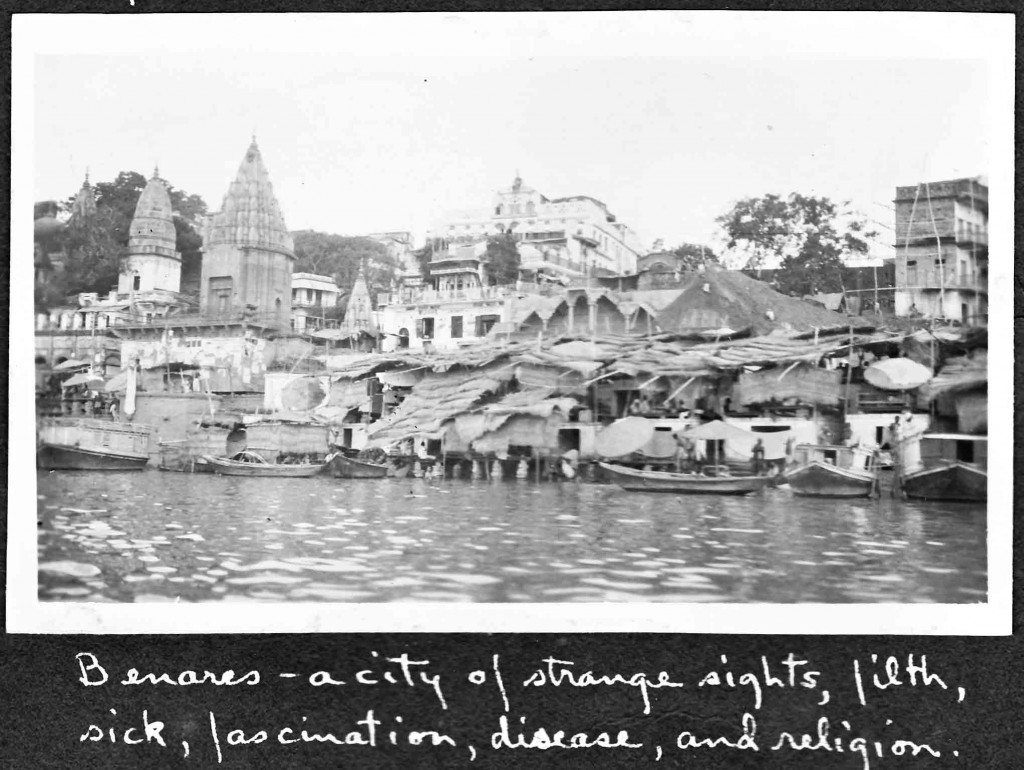
Soon the two pyres were all in flame and as the cloth burnt off in places you could see the flesh sizzling and burning off, then the bones gradually disappearing. Those about paid but slight attention to what was happening. They laughed and joked, small children chased about playing. Instead of being the morbid, pitiful sight of the dead man we had seen shortly before, it struck me as a good sensible way.
Following the ghats we at last came to the mosque where we climbed the ladder-like steps and commenced anew our aimless wandering through narrow streets. Had a good dinner and went to bed early in the yard.
 Benares is quite different from other places we have seen. Here are collected an admixture of all types of people. There are dozens of holy men, dirty, mostly naked, with a wig of long, wild, coarse, brown hair standing out in all directions and with their beggar bowl in one hand. Here for the first time I have had them ask me for baksheesh. They stop at any Hindu’s shop and ask for food—and I have yet to see one refused. Then these are widows—these are a pitiful class. Many come here after their husband’s death to meditate and be “near” him. Their head is shaven or the hair is all clipped off. They too beg
Benares is quite different from other places we have seen. Here are collected an admixture of all types of people. There are dozens of holy men, dirty, mostly naked, with a wig of long, wild, coarse, brown hair standing out in all directions and with their beggar bowl in one hand. Here for the first time I have had them ask me for baksheesh. They stop at any Hindu’s shop and ask for food—and I have yet to see one refused. Then these are widows—these are a pitiful class. Many come here after their husband’s death to meditate and be “near” him. Their head is shaven or the hair is all clipped off. They too beg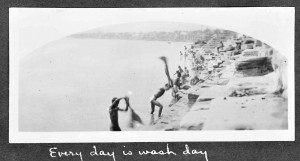 from one street to another, miserable wrecks. There are homes here for them where they are given free shelter and food, and their begging is done for extra luxuries or for money to give to a temple. Miss Mayo’s choicey remarks about the lot of the Indian widow is false, for many do remarry as they do at home and prejudice against remarriage is weakening. The same might be said of child marriage—there are practically no such marriages except in the depressed classes, and then only seldom. Even then there is not cohabitation till the girl is 16.
from one street to another, miserable wrecks. There are homes here for them where they are given free shelter and food, and their begging is done for extra luxuries or for money to give to a temple. Miss Mayo’s choicey remarks about the lot of the Indian widow is false, for many do remarry as they do at home and prejudice against remarriage is weakening. The same might be said of child marriage—there are practically no such marriages except in the depressed classes, and then only seldom. Even then there is not cohabitation till the girl is 16.
The men in this city are unusually well-built as a whole. I have also seen more fat men here than elsewhere. The kids continue to have fat little bellies sticking out like a roly-poly.
